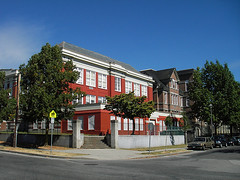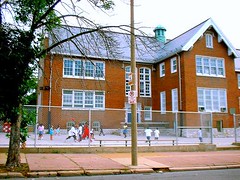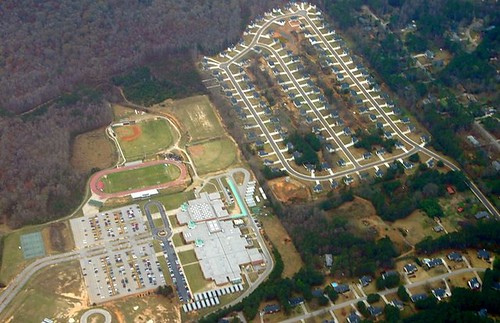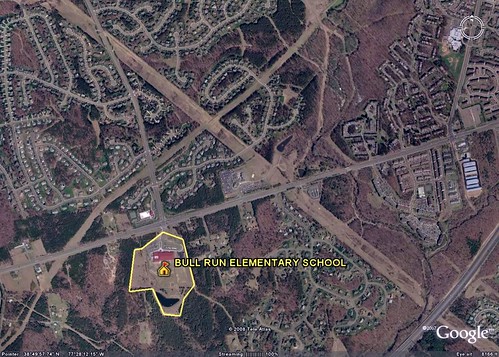A photo essay on school sprawl (part 1)

Posted September 18, 2008 at 1:34PM
How in the world did we get from this . . .
To this?
Even worse, why have we moved away from this . . .
Just so we can build this?
Schools used to be the heart of a neighborhood or community. Children and not a few teachers could walk to class, or to the playground or ball field on the weekend. This was relatively easy to do, because the schools were placed within, not separated from, their neighborhoods. They were human-scaled and their architecture was not just utiliatarian, but signaled their importance in the community. Now it has become hard to tell one from a Walmart or Target.
I was moved to find and show these photos by a couple of things: First, when our LEED for Neighborhood Development committee met last week, we had a healthy discussion on the subject and adopted some draft revisions to make sure that our standards reward true neighborhood-scaled schools, not sprawling ones. Second, I noticed a story in the newspaper about a school system in a fast-growing county that was looking at a two hundred and thirty acre site for a new high school.
Sound far-fetched? A neighborhing county already has a high school on a157-acre site, below. That, incidentally, is roughly twice the size of Disneyland in California and about half again as large as the Magic Kingdom at Walt Disney World in Florida. Here is the school:
Note that the parking lot is larger than the school itself, and about as large as the football and soccer fields combined.
In both aerial photos above, note also the utter lack of connectivity to the surrounding area, not that there is much to connect to. So much for being "the heart of the community" and so much for even the remote likelihood of walking.
The problem extends to elementary schools, too - the ones that should be the most closely integrated into the neighborhood. Look below at a new suburb in Virginia (whose school is ironically named after one of the most famous rural places in American history). The cul-de-sac layout of the subdivisions that are nearby makes walking inconvenient to start with, but to compound the matter the school is placed on an isolated tract separated from the rest of the community.
How did schools become agents of sprawl rather than antidotes to it? In its seminal publication Why Johnny Can't Walk to School, the National Trust for Historic Preservation points out that it has not been by accident. School districts across the country have adopted nationally-recommended minimum acreage standards that not only are much larger than necessary but also force administrators to seek very large parcels that, by definition, are beyond the edge of existing communities. And it gets worse: published in 2000 and written by my friend Constance Beaumont and her co-author Elizabeth Pianca, Why Johnny Can't Walk also highlights a concurrent set of policies that require administrators to raze or abandon existing schools if the cost of rehab reaches a certain percentage of the cost of a new one.
This is basically legally mandated disinvestment and legally mandated sprawl.
If you want to get really disturbed, you can check out an Illinois high school's web site that unwittingly shows step-by-step how, over the decades, essentially the same school has gone from a traditional one to something that now resembles a strip mall. Look at "the phases of JCHS." (At least the fight song is cool.) Sigh.
Tomorrow: some better ways. (Read Part 2 here.)









